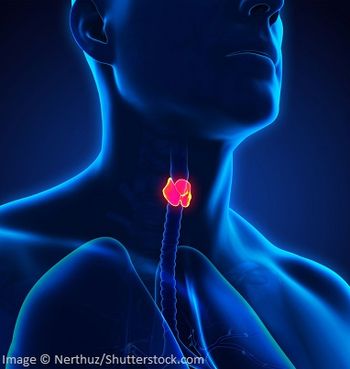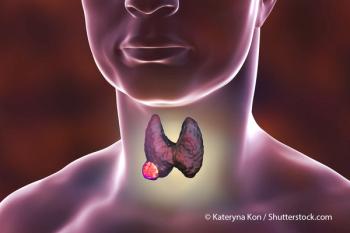
Oncology NEWS International
- Oncology NEWS International Vol 19 No 4
- Volume 19
- Issue 4
Thyroid Cancer: Shifts in Surgical Management and Follow-up
Current treatment methods may offer little more than overtreatment, while follow up should not automatically mean expensive and unnecessary tests.
ABSTRACT: Current treatment methods may offer little more than overtreatment, while follow up should not automatically mean expensive and unnecessary tests.
For years the standard treatment for differentiated thyroid carcinoma has been subtotal or total thyroidectomy followed by radioiodine ablation. But experts in the surgical management of thyroid cancer have begun to question this one-size-fits-all approach. Similarly, new rules apply to the post-treatment follow-up for a disease whose burden is quite low compared with other solid tumors.
Jatin P. Shah, MD, PhD, from Memorial- Sloan Kettering Cancer Center, and David S. Cooper, MD, chair of the American Thyroid Association (ATA) Thyroid Cancer Guidelines Task Force offered their perspectives on these new rules in surgical management and follow up.
A wide spectrum of disease
Tg assays: Mostly created equal
A 2009 study out of Canada compared four methods for Tg quantitation and three methods for detection and quantitation of Tg antibodies (Tg-Ab). They found good agreement between methods for quantitation of Tg, though noted that "closer agreement was expected as the assays are all calibrated to the same reference standard (CRM 457)." However, they found for Tg-Ab assays the rate of antibody positivity ranged from 9% to 21% in their group of patients, and there was agreement in only 6% of cases.
They concluded that "all the thyroglobulin assays appear to be suitable for monitoring patients with thyroid cancer, provided the differences in calibration are taken into account... when changing assays. Conversely, the antithyroglobulin assays are virtually useless, since there appears to be very little agreement...and no evidence of assay interference in the measurements of thyroglobulin" (
Clin Biochem
42:416-419, 2009).
"Thyroid cancer is not one disease. It is a spectrum made up of a variety of diseases with different behaviors under one label: thyroid cancer," Dr. Shah said.
"People need to understand the disease before taking on the responsibility of treating it. If you don't understand the disease, then you are perpetuating ignorance in treating your patients," added Dr. Shah, who is professor of surgery and E.W. Strong Chair in Head & Neck Oncology as well as chief of the head and neck service at the New York-based institution.
Increased understanding of the biological progression of neoplastic transformation of thyroid follicular cells has shed new light on the natural history of differentiated thyroid cancer, he said.
"We now know that tumor progression from a well-differentiated to less well-differentiated and undifferentiated carcinoma occurs in a predictable fashion. In addition to histology, other independent parameters of prognosis are age, tumor size, extrathyroidal extension, distant metastasis, and completeness of surgical removal.
Based on these prognostic factors, risk classifications of low, intermediate, and high risk have been developed for differentiated thyroid cancer.
The great majority of patients with thyroid cancer are low-risk, and 70% to 85% of them are cured by their initial operation, whether that is lobectomy or total thyroidectomy. For instance, low-risk patients who have a single intrathytoidal nodule, without any extrathyroid extension, in one lobe while the other lobe is normal are cured by a simple lobectomy. They require no other treatment, Dr. Shah said.
Similarly, low-risk patients with bilobar abnormalities will be cured by total thyroidectomy alone. "At Memorial-Sloan Kettering, for our low-risk patients who undergo total thyroidectomy, we measure their thyroglobulin [Tg] six to eight weeks after surgery. If their unstimulated Tg is 1 ng/ml or less, we consider they are cured. They do not need radioactive iodine," Dr. Shah said.
He added that the entire idea of total or subtotal thyroidectomy in a patient who needs total thyroidectomy by virtue of bilateral disease or abnormalities, is a wrong concept, yet it is still promulgated. "If you are operating for cancer, why do you want to leave remnant thyroid tissue behind?" he said. "It doesn't make sense to me. If the purpose of the surgery is to treat a thyroid cancer, then there are only two operations: extracapsular lobectomy for a single intrathyroidal nodule or, for bilateral disease, extracapsular total thyroidectomy, leaving no thyroid tissue behind. These will cure the majority of patients."
Dr. Shah acknowledged that high-risk patients, such as those with advanced tumors with invasion of the viscera of the central compartment, require aggressive surgery to remove all demonstrable disease and adjuvant treatment with radioactive iodine or radiation therapy. But these patients are few and far between, he said.
Overtreatment of thyroid cancer in lowrisk patients does not improve survival and may actually increase morbidity from excessive surgery and unnecessary radiation. Dr. Shah said he believes too many unnecessary operations are being done, especially for microscopic disease, which have no impact on survival or recurrence.
"We can now identify microscopic or occult disease, thanks to new technologies, and this has become an indication to treat. But occult disease does not need to be treated. We didn't do ultrasensitive Tg or ultrasound [exams] 20 years ago, and so we didn't treat these patients. Still, we reported 100% cure rates in the low-risk patient. So how are we going to improve on a 100% cure rate?"
Recurrence risk drives intensity of follow-up
In agreement with Dr. Shah, Dr. Cooper stressed that the prognosis for the vast majority of thyroid cancer patients is excellent. Following these patients after their initial treatment must be done prudently so as not to overburden patients with expensive and unnecessary tests.
Dr. Cooper presented updated recommendations for the follow-up of thyroid cancer from the 2009 ATA guidelines (Thyroid 19:1167-1214, 2009).
"Most people with thyroid cancer do not die from their disease," said Dr. Cooper who is also professor of medicine at Johns Hopkins University in Baltimore. "The recurrence rate varies from 10% to 30% and it has been assumed that if these recurrences are detected and treated sooner rather than later, then people will live longer. However, this assumption has not been proven."
The intensity of follow-up for thyroid cancer relates to the patient's risk for recurrence, but this is variable and depends on the risk at presentation. "A tumor size of three centimeters or more and tumor histology predict mortality and recurrence, so risk stratification can be used to talk about both," Dr. Cooper said.
He called the serum Tg assay an essential tool in the follow-up of thyroid cancer. The 2009 ATA Guidelines specify that all assays should be normalized against the international CRM-457 standard (see Related Reading). The guidelines also recommend periodic Tg measurements in low-risk patients who are not treated with subtotal thyroidectomy and/or radioiodine.
"We didn't have this in the guidelines before, but there is now an emerging population of people who are not getting a total thyroidectomy and who are not getting radioiodine because they are considered to have low-risk disease. We have to address follow up in these people in some way," Dr. Cooper said.
Another new guideline is to measure Tg after thyroxine withdrawal or recombinant thyroid stimulating hormone (TSH) treatment to verify the absence of disease in some low-risk patients. These patients have been treated with radioactive remnant ablation, have a negative cervical ultrasound, and have undetectable Tg on suppression within their first year of treatment. This measurement should be done approximately one year after the ablation. The guidelines also recommend a cervical ultrasound six to 12 months after surgery.
If the ultrasound and TSH tests do not reveal disease, the patient can be followed with a yearly clinical exam and Tg test on thyroid hormone replacement rather than repeating the TSH stimulated testing multiple times, Dr. Cooper said. "The idea here is that once the recombinant stimulated TSH has been shown to be undetectable, the yield of doing it over and over and over again is very low and probably not cost-effective."
Finally, the current guidelines define individuals who are free of tumor as having no clinical evidence of tumor, no imaging evidence of tumor, and undetectable Tg during suppression and stimulation in the absence of interfering antibodies," Dr. Cooper said.
References:
Source:
2009 World Congress on Thyroid Cancer
Articles in this issue
over 15 years ago
High dietary polyamines may foster colorectal adenomasover 15 years ago
Duke doctor named new chair of NCCN board of directorsover 15 years ago
Study sheds light on lung cancer and African Americansover 15 years ago
Everolimus achieves ‘potent’ results in rare form of NHLover 15 years ago
Who's Newsover 15 years ago
Analgesic use may decrease postmenopausal estrogen levelsover 15 years ago
Healthcare legislation boosts future of cancer care servicesover 15 years ago
Complete resection of kidney mets ups overall survivalNewsletter
Stay up to date on recent advances in the multidisciplinary approach to cancer.

















































































